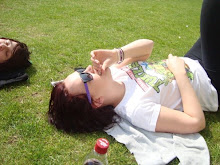

 Last week I joined a few of the 'Graphics and Print' guys to learn how to use the letterpress. It was by far the most tedious thing I've had to do on this course, but at the same time I found it quite therapeutic. I always get a strange sense of satisfaction out of really practical, hands on work and it took so much concentration to load all of the font pieces into the bed.
Last week I joined a few of the 'Graphics and Print' guys to learn how to use the letterpress. It was by far the most tedious thing I've had to do on this course, but at the same time I found it quite therapeutic. I always get a strange sense of satisfaction out of really practical, hands on work and it took so much concentration to load all of the font pieces into the bed.Your text must be reversed in the bed in order to read the right way when printed - so to load the bed you still insert the letters from left to right, but you work upside down. Yes. Confusing.
The length of your lines of text has to match the length of the leading exactly. It's incredibly frustrating trying to find the right combination of spacing because most of the time your line will be out by a hair's width - once you over space one line, even fractionally, the others begin to wobble.
The press itself I found relatively easy to use - some people struggled achieving a fluent motion with the roller as you have to walk with it whilst guiding and extracting your paper. I've always been quite good with hand-eye co-ordination though, and that definitely helped.
 Above is a scan of one of my prints (they're all the same), highlighting each typo. It's difficult to spot misplaced letters when setting up the pieces as they're so small, but when printed they stand out like a sore thumb causing words to look poorly aligned.
Above is a scan of one of my prints (they're all the same), highlighting each typo. It's difficult to spot misplaced letters when setting up the pieces as they're so small, but when printed they stand out like a sore thumb causing words to look poorly aligned. Also highlighted is the 'fl' piece. When trying to set two letters together such as 'f' and 'l' or 'f' and 'i' it can't physically be done because the top of the 'f' pushes the other letters out of the way, which would cause them to snap if they went through the press. So there are specially designed pieces to accommodate such combinations.


No comments:
Post a Comment